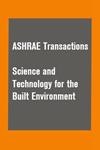Comparisons of load-based and AHRI 210/240 testing and rating for residential heat pumps
IF 1.7
4区 工程技术
Q3 CONSTRUCTION & BUILDING TECHNOLOGY
Science and Technology for the Built Environment
Pub Date : 2023-04-20
DOI:10.1080/23744731.2023.2203043
引用次数: 1
Abstract
The current testing and rating procedure for residential air conditioners and heat pumps is based on a steady-state performance measurement approach with a degradation coefficient to account for cycling losses at part-load conditions. Test equipment performance is measured under various ambient conditions with varying compressor and fan speeds, and the results are propagated through a temperature-bin method to estimate seasonal performance. Although the current rating approach offers a standardized performance metric for comparing the relative performances of different equipment, it involves disabling the native controls and, as a result, does not consider the impact of integrated controls for test units and their dynamic interactions with representative building loads. As an alternative, a load-based testing methodology (CSA EXP07) has been developed in which the dynamic performance of equipment is measured in a test facility by allowing it to respond to a simulated virtual building model. This study compares the steady-state and dynamic load-based performance measurement methodologies for use on a 5-ton residential heat pump system in order to understand the differences and their significance for the next-generation rating procedure. The differences in the two test methodologies' performance evaluation results are discussed with a causal analysis of the observed differences.住宅热泵基于负荷和AHRI 210/240测试和额定值的比较
目前住宅空调和热泵的测试和评级程序基于稳态性能测量方法,该方法具有退化系数,以考虑部分负荷条件下的循环损耗。测试设备性能是在压缩机和风扇转速不同的各种环境条件下测量的,结果通过温度箱法传播,以估计季节性能。尽管当前的评级方法提供了一个标准化的性能指标来比较不同设备的相对性能,但它涉及禁用本地控制,因此,没有考虑集成控制对测试单元的影响及其与代表性建筑荷载的动态相互作用。作为一种替代方案,已经开发了一种基于负载的测试方法(CSA EXP07),其中通过允许设备响应模拟的虚拟建筑模型,在测试设施中测量设备的动态性能。本研究比较了用于5吨住宅热泵系统的稳态和动态负荷性能测量方法,以了解其差异及其对下一代评级程序的意义。通过对观察到的差异进行因果分析,讨论了两种测试方法的性能评估结果的差异。
本文章由计算机程序翻译,如有差异,请以英文原文为准。
求助全文
约1分钟内获得全文
求助全文
来源期刊

Science and Technology for the Built Environment
THERMODYNAMICSCONSTRUCTION & BUILDING TECH-CONSTRUCTION & BUILDING TECHNOLOGY
CiteScore
4.30
自引率
5.30%
发文量
78
期刊介绍:
Science and Technology for the Built Environment (formerly HVAC&R Research) is ASHRAE’s archival research publication, offering comprehensive reporting of original research in science and technology related to the stationary and mobile built environment, including indoor environmental quality, thermodynamic and energy system dynamics, materials properties, refrigerants, renewable and traditional energy systems and related processes and concepts, integrated built environmental system design approaches and tools, simulation approaches and algorithms, building enclosure assemblies, and systems for minimizing and regulating space heating and cooling modes. The journal features review articles that critically assess existing literature and point out future research directions.
 求助内容:
求助内容: 应助结果提醒方式:
应助结果提醒方式:


